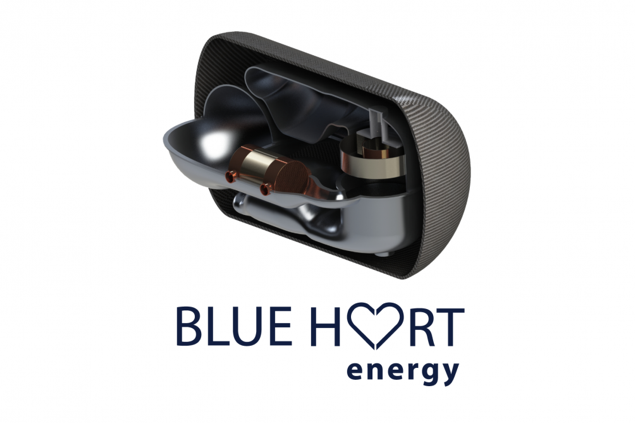The spin-off of the spin-off | A smaller, cheaper and very versatile heat pump has been designed that will give the energy transition a boost. Blue Heart Energy wants to bring this new heat pump to the market in 2023.
Author: Linda Bak, Innovation Origins | 21 January 2021
In order to reduce CO2 emissions, we need to heat our homes differently. The central heating boiler system (condensing boiler) is making way for a heat pump system and even a heat network for the entire neighbourhood. Today’s heat pump compressors are large, complicated and expensive machines. But there is another way – using a thermoacoustic heat pump. This is a relatively new technology that uses sound to move heat from lower to higher temperatures.
 The most significant advantage? A thermoacoustic heat pump is capable of using a flexible heat source and can release heat at different temperatures. “That makes this heat pump very suitable for homes,” states Michiel Hartman, co-founder and manager of Blue Heart Energy, a spin-off from the Netherlands Organisation for Applied Scientific Research (TNO). A temperature of 60 to 70 degrees is needed for tap water, while a temperature of 40 degrees is enough for underfloor heating. “A thermoacoustic heat pump can do both, whereas this is still difficult for current heat pump compressors. Various systems must then be combined for use in a home, where you need different temperatures. This is what makes the unit so big and complex,” adds Jan-Aiso Lycklama à Nijeholt. He is research and project manager in the field of thermoacoustics at the TNO and works closely with Blue Heart Energy.
The most significant advantage? A thermoacoustic heat pump is capable of using a flexible heat source and can release heat at different temperatures. “That makes this heat pump very suitable for homes,” states Michiel Hartman, co-founder and manager of Blue Heart Energy, a spin-off from the Netherlands Organisation for Applied Scientific Research (TNO). A temperature of 60 to 70 degrees is needed for tap water, while a temperature of 40 degrees is enough for underfloor heating. “A thermoacoustic heat pump can do both, whereas this is still difficult for current heat pump compressors. Various systems must then be combined for use in a home, where you need different temperatures. This is what makes the unit so big and complex,” adds Jan-Aiso Lycklama à Nijeholt. He is research and project manager in the field of thermoacoustics at the TNO and works closely with Blue Heart Energy.
Michiel Hartman and Jan-Aiso Lycklama à Nijeholt
Different sources
The system’s flexibility is noticeable on the output side, but also on the heat source side. A heat pump invariably works with one particular source, a kind of starting point, for example groundwater or air. “Whereas the thermoacoustic heat pump is capable of working with different sources that have fluctuating temperatures,” Lycklama à Nijeholt explains. Outdoor air of -10 degrees or +30 degrees can both act as sources. “That makes our heat pump easier to use in countries with varying climates than is the case with heat pump compressors. These only work with a certain, much more limited range of source temperatures,” he adds.

Photo: Blue Heart Energy
Also, heat from a data center, for example, can be used more easily this way as a source for a thermoacoustic heat pump. “We’re embarking on a project to see if we can use the cooling discharge from solar panels as a source for the heat pump,” says the researcher. Since the temperature of the water fluctuates throughout the seasons, this is a difficult source for a compression heat pump. However, thermoacoustics makes the use of this kind of water possible.
Sound waves
So how does this technology work exactly? When a gas expands, as is the case with helium, the temperature drops. And when it compresses the temperature goes up again. “We make use of that effect in the thermo-acoustic heat pump,” says Lycklama à Nijeholt. Near the heat source, gas is at a relatively low temperature in the first low-temperature heat exchanger. As the gas expands, the temperature drops further and heat from the source is absorbed by the gas. Then the gas is moved with a thermoacoustic wave, a sound wave, to a second heat exchanger. There, the gas is compressed and the temperature goes up, releasing heat to the second heat exchanger. That second heat exchanger is connected to the heat circuit in a home through which it releases heat. Despite using sound waves in the heat pump, the unit is completely silent on the outside.
To the market
In the meantime, researchers have proven in the lab that this new heat pump does indeed work. Now it is time to actually bring the technology to the market. “Spin-offs like Blue Heart energy are indispensable for that step in the development process,” says Lycklama à Nijeholt. Entrepreneur Michiel Hartman sees plenty of opportunities for the thermoacoustic heat pump. This system only needs electricity to provide heat, which makes it a sustainable solution for heating homes. Hartman read about TNO’s research in this area and contacted them with a view to working together. That resulted in the formation of Blue Heart Energy spin-off back in 2016.
Lycklama à Nijeholt: “A spin-off is the next step in terms of technological development. As researchers, we are not easily satisfied with the performance of a system. We just keep on developing it until it’s perfect before we hit the market.” But according to the researcher, it is better to launch something onto the market earlier. Hartman goes on to say: “As a company, you do have to enter the market, you have got to make money. That’s so different when you’re working with grants and budgets in the field of research.” Moving to the market also raises other matters concerning the product, such as the optimization of weight and cost price. “We look at this with a commercial eye and set up partnerships with potential customers that way,” he says.
First customers
“We are reaching out to suppliers and asking them to participate in the development of the product,” Hartman continues. “All the time and money that they invest now, they will get back later on because we will eventually buy products or parts from them. That’s a whole different mindset and way of working together.” The first customers for Blue Heart Inside, as the spin-off’s heat pump is called, have already lined up to buy the product in 2023.
Blue Heart Energy will build its second prototype over the coming month. Aside from that, the company is going to start a project to produce a definitive market product. This should be ready in early 2023. Blue Heart Energy’s customers are water pump manufacturers. They buy the Blue Heart Inside so they can replace the compressor part of their existing heat pumps. This will also replace the refrigerant that they use. This cooling agent is needed to regulate the temperature in heat pump compressors, but it is not good for the environment. No such agents are needed for the Blue Heart Inside.
Housing corporations
As the new heat pump is a lot smaller and simpler than current heat pump compressors, housing associations are very enthusiastic about the product. “Maintaining the current heat pump systems is very difficult and expensive for the owners of multiple properties, such as housing corporations,” Hartman states. “They are very interested in a unit that is smaller and easier to maintain.” Incidentally, the same holds true for a lot of private homeowners. The efficiency of the thermoacoustic heat pump is comparable to a heat pump compressor. “Because of the flexibility of the new system, it scores even higher than the current heat pump at certain times, especially when temperature levels vary,” he explains.
The spin-off is now working with partners throughout Europe. The European market therefore forms the launching point for sales of the Blue Heart Inside. Hartman then wants to expand its sales to America and Asia. In the future, it will also be possible to cool houses with the thermoacoustic heat pump. “This can be achieved with the same system so then only one unit needs to be installed,” Hartman states. That makes the unit interesting for people all over the world. After all, everyone will eventually have to switch to a more sustainable way of heating and cooling.
In addition to the launch on the market, research into the thermoacoustic heat pump is set to continue. “We will keep on looking for ways to optimize the system,” Lycklama à Nijeholt asserts. “In the early stages, this is achieved with huge leaps and bounds. These gradually become smaller and smaller, but there is always room for improvement.”